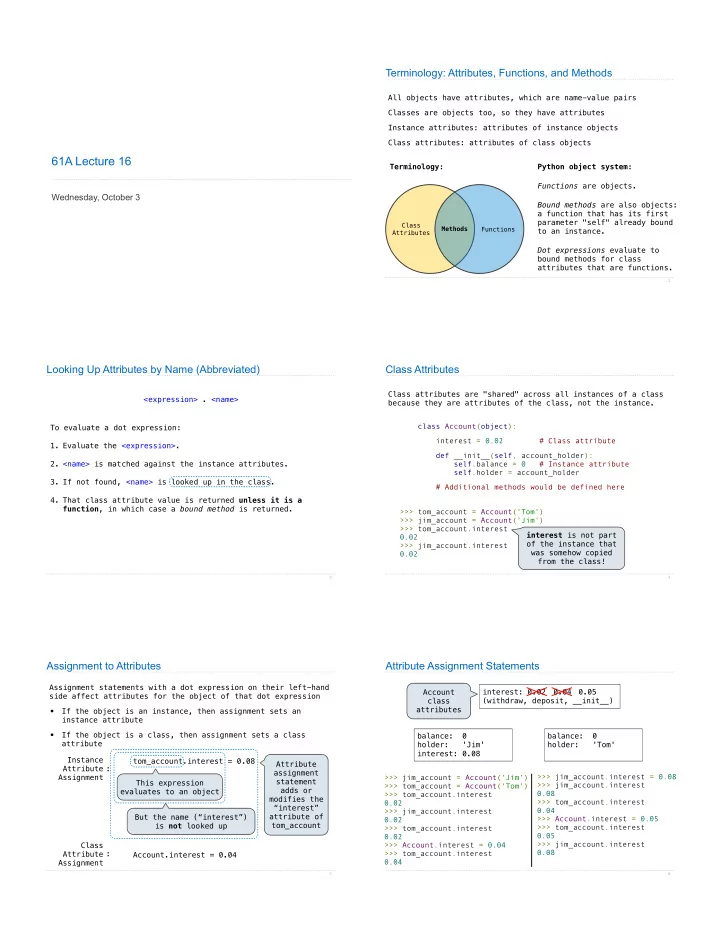

Terminology: Attributes, Functions, and Methods All objects have attributes, which are name-value pairs Classes are objects too, so they have attributes Instance attributes: attributes of instance objects Class attributes: attributes of class objects 61A Lecture 16 Terminology: Python object system: Functions are objects. Wednesday, October 3 Bound methods are also objects: a function that has its first parameter "self" already bound Class Methods Functions to an instance. Attributes Dot expressions evaluate to bound methods for class attributes that are functions. 2 Looking Up Attributes by Name (Abbreviated) Class Attributes Class attributes are "shared" across all instances of a class <expression> . <name> because they are attributes of the class, not the instance. class Account(object): To evaluate a dot expression: interest = 0.02 # Class attribute 1. Evaluate the <expression>. def __init__(self, account_holder): 2. <name> is matched against the instance attributes. self.balance = 0 # Instance attribute self.holder = account_holder 3. If not found, <name> is looked up in the class. # Additional methods would be defined here 4. That class attribute value is returned unless it is a function , in which case a bound method is returned. >>> tom_account = Account('Tom') >>> jim_account = Account('Jim') >>> tom_account.interest interest is not part 0.02 of the instance that >>> jim_account.interest was somehow copied 0.02 from the class! 3 4 Assignment to Attributes Attribute Assignment Statements Assignment statements with a dot expression on their left-hand Account interest: 0.02 0.04 0.05 side affect attributes for the object of that dot expression (withdraw, deposit, __init__) class • attributes If the object is an instance, then assignment sets an instance attribute • If the object is a class, then assignment sets a class balance: 0 balance: 0 attribute holder: 'Jim' holder: 'Tom' interest: 0.08 Instance tom_account.interest = 0.08 Attribute Attribute : assignment >>> jim_account.interest = 0.08 Assignment >>> jim_account = Account('Jim') statement This expression >>> jim_account.interest >>> tom_account = Account('Tom') adds or evaluates to an object 0.08 >>> tom_account.interest modifies the 0.02 >>> tom_account.interest “interest” 0.04 >>> jim_account.interest But the name (“interest”) attribute of >>> Account.interest = 0.05 0.02 tom_account is not looked up >>> tom_account.interest >>> tom_account.interest 0.05 0.02 >>> jim_account.interest Class >>> Account.interest = 0.04 : >>> tom_account.interest 0.08 Attribute Account.interest = 0.04 Assignment 0.04 5 6
Inheritance Inheritance Example A technique for relating classes together A CheckingAccount is a specialized type of Account. Common use: Similar classes differ in amount of specialization >>> ch = CheckingAccount('Tom') >>> ch.interest # Lower interest rate for checking accounts Two classes have overlapping attribute sets, but one 0.01 represents a special case of the other. >>> ch.deposit(20) # Deposits are the same 20 >>> ch.withdraw(5) # Withdrawals incur a $1 fee class <name>(<base class>): 14 <suite> Most behavior is shared with the base class Account Conceptually, the new subclass "shares" attributes with its base class. class CheckingAccount(Account): """A bank account that charges for withdrawals.""" The subclass may override certain inherited attributes. withdraw_fee = 1 interest = 0.01 Using inheritance, we implement a subclass by specifying def withdraw(self, amount): return Account.withdraw(self, amount + self.withdraw_fee) its difference from the the base class. 7 8 Looking Up Attribute Names on Classes Designing for Inheritance Base class attributes aren't copied into subclasses! Don't repeat yourself; use existing implementations. Attributes that have been overridden are still accessible To look up a name in a class. via class objects. 1. If it names an attribute in the class, return Look up attributes on instances whenever possible. the attribute value. 2. Otherwise, look up the name in the base class, class CheckingAccount(Account): if there is one. """A bank account that charges for withdrawals.""" withdraw_fee = 1 >>> ch = CheckingAccount('Tom') # Calls Account.__init__ interest = 0.01 >>> ch.interest # Found in CheckingAccount 0.01 def withdraw(self, amount): >>> ch.deposit(20) # Found in Account return Account.withdraw(self, amount + self.withdraw_fee) 20 Attribute look-up Preferable alternative to >>> ch.withdraw(5) # Found in CheckingAccount on base class CheckingAccount.withdraw_fee 14 9 10 Designing for Inheritance: General Base Classes Inheritance and Composition Base classes may contain logic that is meant for subclasses. Object-oriented programming shines when we adopt the metaphor. Example: Same CheckingAccount behavior; different approach Inheritance is best for representing is-a relationships. E.g., a checking account is a specific type of account. So, CheckingAccount inherits from Account. Composition is best for representing has-a relationships. Demo E.g., a bank has a collection of bank accounts it manages. So, A bank has a list of Account instances as an attribute. No local state at all? Just write a pure function! 11 12
Multiple Inheritance Multiple Inheritance class SavingsAccount(Account): A class may inherit from multiple base classes in Python. deposit_fee = 2 def deposit(self, amount): return Account.deposit(self, amount - self.deposit_fee) class AsSeenOnTVAccount(CheckingAccount, SavingsAccount): def __init__(self, account_holder): self.holder = account_holder A class may inherit from multiple base classes in Python. self.balance = 1 # A free dollar! CleverBank marketing executive wants: • Low interest rate of 1% • A $1 fee for withdrawals >>> such_a_deal = AsSeenOnTVAccount("John") Instance • A $2 fee for deposits attribute >>> such_a_deal.balance • A free dollar when you open your account 1 SavingsAccount >>> such_a_deal.deposit(20) class AsSeenOnTVAccount(CheckingAccount, SavingsAccount): method def __init__(self, account_holder): 19 self.holder = account_holder >>> such_a_deal.withdraw(5) CheckingAccount self.balance = 1 # A free dollar! method 13 13 14 Resolving Ambiguous Class Attribute Names Human Relationships Account Some_Guy Grandma Grandpa Grandaddy Gramammy CheckingAccount SavingsAccount AsSeenOnTVAccount Double Half Aunt Mom Dad Double Half Uncle Some_Dude >>> such_a_deal = AsSeenOnTVAccount("John") Instance attribute >>> such_a_deal.balance You Quadruple Double Half Cousin 1 SavingsAccount >>> such_a_deal.deposit(20) method 19 >>> such_a_deal.withdraw(5) CheckingAccount method 13 15 16
Recommend
More recommend